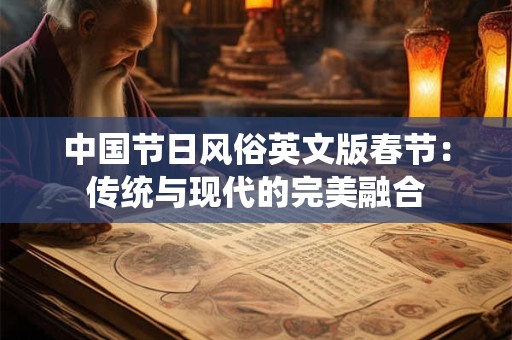The Spring Festival, also known as Chinese New Year, is a time when the entire nation is filled with joy and excitement. It is a grand celebration that combines traditional customs with modern elements, creating a unique and vibrant atmosphere.
1. Historical Roots of the Spring Festival
The Spring Festival has a long history, dating back over 4,000 years. It originated from the ancient Chinese practice of worshiping gods and ancestors. Over time, it has evolved into a festive occasion that is celebrated by people of all ages and backgrounds.
2. Preparations for the Spring Festival
The excitement for the Spring Festival begins weeks in advance. People clean their homes thoroughly, believed to sweep away bad luck and welcome good fortune. Red decorations, such as lanterns, couplets, and paper cuttings, are hung to symbolize happiness and prosperity.

3. The Reunion Dinner
The most important event of the Spring Festival is the reunion dinner, also known as the "Lantern Festival." Families gather together to share a sumptuous meal, which often includes traditional dishes like dumplings, fish, and nian gao (sticky rice cake). The dinner is a time for expressing gratitude and strengthening family bonds.
4. Fireworks and Firecrackers
Fireworks and firecrackers are a key part of the Spring Festival celebration. They are set off to ward off evil spirits and attract good luck. The vibrant colors and loud noises create an electrifying atmosphere, adding to the festive mood.
5. Red Envelopes and Gifts
Red envelopes, known as "hongbao" in Chinese, are a popular tradition during the Spring Festival. Elders give red envelopes containing money to the younger generation, symbolizing good wishes and blessings. Additionally, people exchange gifts with friends and family to foster strong relationships.
6. Traditional Performances
Traditional performances, such as dragon and lion dances, are a highlight of the Spring Festival. These performances are believed to bring good fortune and prosperity to the community. The dynamic movements and colorful costumes captivate the audience, creating a sense of excitement and joy.
7. The Legend of Nian
The Spring Festival is also associated with the legend of Nian, a fearsome beast that would attack villages during the winter months. To protect themselves, people would decorate their homes with red lanterns and paper cuttings, and set off fireworks and firecrackers. The legend has become a symbol of good luck and happiness, and is celebrated during the Spring Festival.
8. Modern Celebrations
In today's modern society, the Spring Festival continues to evolve, incorporating new elements while preserving traditional customs. People celebrate the festival through various means, including social media and online activities. Digital red envelopes, virtual lion dances, and online performances have become popular among younger generations.
9. The Significance of the Spring Festival
The Spring Festival holds great significance in Chinese culture. It symbolizes the beginning of a new year, a time for reflection, renewal, and celebration. It is a time when people come together to honor their ancestors, express gratitude, and wish for a prosperous future.
10. Conclusion
The Spring Festival is a perfect blend of tradition and modernity, showcasing the rich cultural heritage of China. It is a time for joy, unity, and renewal, and it continues to be cherished by people of all ages and backgrounds. As the years go by, the Spring Festival will undoubtedly continue to evolve, but its essence will always remain the same – a celebration of life, love, and happiness.
